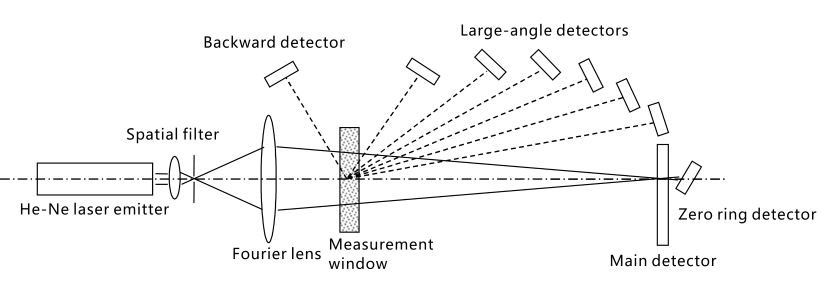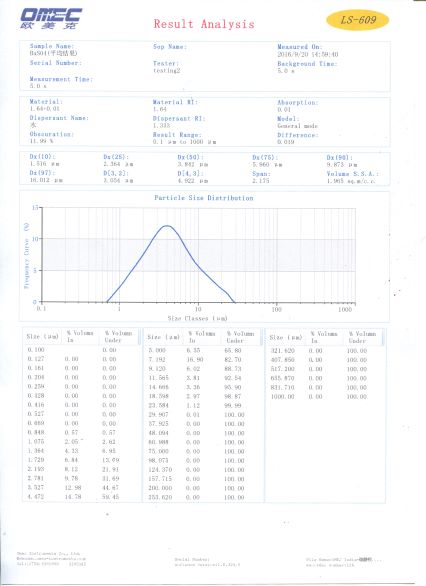Update time:2019-03-26
Applications: Measure the particle size distribution of powder or latex.

LS-609 is a new intelligent and high-performance full-automated laser particle size analyzer. The imported He-Ne laser emitter as light source can realize shorter preheating time and more stable laser power. The modern intelligent measurement control & analysis software and full-automated sample feeding system improve the user experience greatly, LS-609 owns more concise & effective measurement process and more stable & reliable results, it’s easier to compare among measurement reports.
Applications: Measure the particle size distribution of powder or latex.
Principle: Light is an electromagnetic wave. When light meets with particles on it way of traveling, the interaction between light and particles will result in deviations of part of the light, which is called light scattering. The bigger the scattering angle is, the particle size will be smaller, the smaller the scattering angle is, the particle size will be bigger. The particle analyzer instruments will analysis the particle distribution according to this physical character of the light wave.
Specifications:
1. Theory: Mie scattering
2.: Measuring Range: 0.1~1000μm
3. Sample Feeding: wet dispersion
4. Repeatability: <1% (standard sample D50)
5. Alignment: intelligent automated alignment, accuracy of alignment: 0.5μm
6. Scan frequency: 1 kHz
7. Measurement Duration: 1-2 minutes
8. Detectors: 49
9. Light Source: imported He-Ne laser, power: greater than 2.0 mW, wave length: 0.6328 μm
10. Environmental Requirement:
Temperature: 5-35℃
Humidity:<85%
11. Report Items: Particle size distribution table & graph, Average diameter, Median diameter, SSA, etc.
12. Dimension(L X W X H):838 X 265 X 295mm (mainframe), 938 X 365 X 395mm (outer packing)
Technical features
1. Reliable optical platform
1.1. Use horizontal straight light path layout, no reflecting prism, light path is stable and reliable.
1.2. Good designability for base, good consistency of light path.
1.3. GB/T4857.18 drop test has been passed.
1.4. Laser power module uses irrigation method for sealing, good moisture resistance and good electrical stability.
1.5. Modular construction design, maintenance is more convenient.
1.6. Use debugging tools to adjust/position main detector and auxiliary detectors, more accurate positioning. Help to obtain more accurate large-angle light energy data, so as to improve the instrument’s testing performance for small particles.
1.7 The all-in-one housing design, it’s dust-protected and water-proof.
2. Optimized light path structure

Schematic diagram of optical path
2.1. Light path system is fully-enclosed, dust-proof and it can prevent light pollution.
2.2. Light path adopts lens back Fourier transform structure, the biggest acceptance angle isn’t restricted by the lens aperture, the backward detector can realize the extension of measurement lower limit to 0.1μm.
2.3. Optical source adopts imported He-Ne laser emitter which owns better monochromaticity, high coherence, small divergence angle and better stability compared to other laser emitters.
2.4. For laser emitter, except for traditional detection of output power value, we add the stability test of output power. We also adopt the patent design of integrated laser emitter (patent no.: 00228952.0) which reduces heat distortion of laser tube and external mechanical vibration.
2.5. Smoothing processing technology is used to reduce the impact of laser emitter’s power fluctuation to measurement.
2.6. The constant voltage and limited current, filling treatment technology reduce the probability of laser emitter flashing to extremely low.
2.7. Spatial filter is fixed by super permanent magnet to protect the pinhole from skewing, which improves the stability of light path greatly, the new design eliminates the diffraction rings of laser effectively, the light energy data will be more accurate, it’s better for measuring large particles.
2.8. Automated alignment device can realize more accurate alignment quickly, helps to prolong its service life. The accuracy of alignment can reach 0.5μm.
2.9. Detector array adopts unique scattered light detection around a sphere surface (DAS) (patent no.: 95223756.3), the large angle detectors are placed in a spherical surface to get accurate focus of the large angle scattered light.
3. Advanced data collection and processing technology
3.1. Using 8-channel simultaneous sampling to sample 16 bit ADC, the sampling frequency of frame data can reach 1 kHz.
3.2. Using 64-channel simultaneous sampling technology and sample & hold switch with ultralow leakage current, the full scale accuracy can reach 0.15%.
3.3. Firmware update and data configuration are available, more convenient for maintenance and operation.
3.4. High-quality components, lower failure rate.
3.5. Offset function of electric background, it can help to get more accurate optical energy data.
4. Friendly & practical software Functions:
4.1. SOP standardization operating procedure function, it standardizes the analysis & testing process.
4.2. The software can real-timely display and can regulate the status of automated sample feeder.
4.3. The software owns intelligent alignment judgement function, time-saving and efficient.
4.4. Intelligent recognition of sampling status.
4.5. Multiple distribution models: general mode, enhanced mode, single mode
4.6. Multiple report models: General purpose, sieving, percentage, average, statistics and fitting reports.
4.7. Report items can be revised according to different industries’ requirements.
4.8. Reports can be exported as PDF, Excel format or other text format files
4.9. Multiple reports can be opened at the same time, easy to compare among reports
4.10. Complete, open database of sample material, owns more than 200 kinds of commonly used material parameters. Users can define refractive index parameters by themselves, including real part and imaginary part (correspond the absorption of sample)
5. Sampling system and its technical features

SCF-105B Circulating Sample Feeding System
5.1 Technical features of SCF-105B Circulating Sample Feeding System
1. Concise and fluent design, elegant appearance.
2. Self-priming pump owns automatic water feeding, drainage and cleaning functions.
3. Realize the communication with the instrument mainframe, all control and actions are executed by software.
4. The system adopts centrifugal pump structure, high cycle efficiency, high capacity and rapid flow rate.
5. Brushless DC motor (imported from Switzerland), adopts round belt drive, can efficiently reduce the vibration and noise.
6. Sample cell adopts open design for the convenience of operation.
7. Motor speed: 0~4000r/min, can realize stepless adjustment, control accuracy: ±20 rpm
8. Capacity of sample cell: 500ml, maximum flow of circulation loop: ≥2.5L/min
9. Built-in bottom ultrasonic function, power can reach 50W, ultrasonic power and time can realize stepless control.
10. Modular design, convenient for overhauling and maintenance.
Report of LS-609: please view next page
